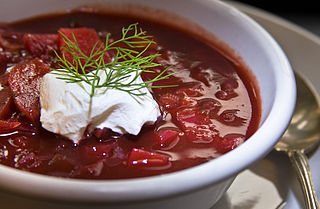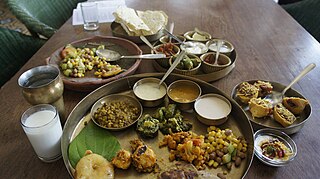
Borscht is a sour soup, made with meat stock, vegetables and seasonings, common in Eastern Europe and Northern Asia. In English, the word borscht is most often associated with the soup's variant of Ukrainian origin, made with red beetroots as one of the main ingredients, which give the dish its distinctive red color. The same name, however, is also used for a wide selection of sour-tasting soups without beetroots, such as sorrel-based green borscht, rye-based white borscht, and cabbage borscht.
Indian cuisine consists of a variety of regional and traditional cuisines native to the Indian subcontinent. Given the diversity in soil, climate, culture, ethnic groups, and occupations, these cuisines vary substantially and use locally available spices, herbs, vegetables, and fruits.

Haleem is a type of stew that is widely consumed in South Asia, the Middle East and Central Asia. Although the dish varies from region to region, it optionally includes wheat or barley, meat and lentils. It is made by slow cooking the meat in lentils and spices. It is served hot with flat breads or on its own. Popular variations of haleem include keşkek in Turkey, Tajikistan, Uzbekistan, Azerbaijan and northern Iraq; harisa in the Arab world and Armenia; halim in Afghanistan, Iran, West Bengal, in Mauritius, Pakistan and Bangladesh; and khichra in India.

Double ka meetha is an Indian bread pudding sweet made of fried bread slices soaked in hot milk with spices, including saffron and cardamom. Double ka meetha is a dessert of Hyderabad. It is popular in Hyderabadi cuisine, served at weddings and parties. Double ka meetha refers to the milk bread, called "double roti" in the local Indian dialects because it swells up to almost double its original size after baking.

South Asian cuisine includes the traditional cuisines from the modern-day South Asian republics of Bangladesh, India, Maldives, Nepal, Pakistan and Sri Lanka, also sometimes including the kingdom of Bhutan and the emirate of Afghanistan. Also sometimes known as Desi cuisine, it has been influenced by and also has influenced other Asian cuisines beyond the Indian subcontinent.

Hyderabadi Muslims, also referred to as Hyderabadis, are a community of Deccani people, from the area that used to be the princely state of Hyderabad in the regions of Marathwada, Telangana, and Kalyana-Karnataka.

Gujarati cuisine is the cuisine of the Indian state of Gujarat. The typical Gujarati thali consists of rotli, dal or curry, rice, and shaak. The thali will also include preparations made from pulses or whole beans such as moong, black eyed beans etc., a snack item (farsaan) like dhokla, pathra, samosa, fafda, etc. and a sweet (mishthaan) like mohanthal, jalebi, sevaiya etc.

Sindhi cuisine refers to the distinct native cuisine of the Sindhi people from Sindh, Pakistan. Sindhi cuisine has been influenced by Central Asian, Iranian, Mughal food traditions. It is mostly a non-vegetarian cuisine, with even Sindhi Hindus widely accepting of meat consumption. The daily food in most Sindhi households consists of wheat-based flat-bread (Mani) or rice accompanied by two dishes, one gravy and one dry with curd, papad or pickle. Freshwater fish and a wide variety of vegetables are usually used in Sindhi cuisine. Restaurants specializing in Sindhi cuisine are rare, although it is found at truck stops in rural areas of Sindh province, and in a few restaurants in urban Sindh.

Khichdi or khichri is a dish in South Asian cuisine made of rice and lentils (dal) with numerous variations. Variations include bajra and mung dalkhichri. In Indian culture, in several regions, especially in the northern areas, it is considered one of the first solid foods that babies eat.

Bun kebab or anda shami is a sandwich that originated in Pakistan, but is now popular all throughout South Asia. Bun kebabs are a signature in Pakistani metro cities like Karachi and Lahore, but they can be found all over Pakistan. Bun Kebab vendors are scattered all across Karachi, vendors on Burns Road being particularly famous, and imitated by frozen bun kebabs sold in South Asian supermarkets across the world. In India, it is eaten as a regular street food, specifically, in the Indian cities of Bhopal, Lucknow, and Hyderabad; it is especially popular with Indian Muslims, the dish is eaten late-night during Ramadan. Bun kebabs are usually sold from roadside stalls, side street vendors, and fast food restaurants. They are also commonly known as anday wala burger. A ‘fried’ version of the bun kebab is popular in Lahore, known as ‘bun plaster’ due to copious amounts of butter and super tender or paste-like kebab mixture used in it. Bun kababs are usually eaten as a main course or snack.
Hyderabadi cuisine, also known as Deccani cuisine, is the cooking style characteristic of the city of Hyderabad and its surrounding area in Telangana, India.

Lukhmi is a typical mince savoury or starter of the cuisine of Hyderabad, Telangana, India. It is a local variation of samosa. The snack's authentic preparation includes stuffing with mutton-mince kheema. It is a non-vegetarian derivative of the samosa although, unlike the latter, the lukhmi is shaped into a flat square patty.

Mirchi ka salan, or curried chilli peppers, is a popular Indian chilli and peanut curry from Hyderabad, Telangana, India, that usually accompanies Hyderabadi biryani alongside dahi chutney. The dish contains green chilli peppers, peanuts, sesame seeds, dry coconut, cumin seeds, ginger and garlic paste, turmeric powder, bay leaf, and thick tamarind juice.
Bihari cuisine is eaten mainly in the eastern Indian state of Bihar, as well as in the places where people originating from the state of Bihar have settled: Jharkhand, Eastern Uttar Pradesh, Bangladesh, Nepal, Mauritius, South Africa, Fiji, some cities of Pakistan, Guyana, Trinidad and Tobago, Suriname, Jamaica, and the Caribbean. Bihari cuisine includes Angika cuisine, Bhojpuri cuisine, Maithil cuisine and Magahi cuisine. Dal Puri
Kairi ka do pyaza is a lamb meat preparation along with unripe green mangoes from Hyderabad, India. Its origin is from Hyderabadi cuisine, and is popular among Hyderabadi Muslims. Dopiaza is an onion gravy preparation with a souring agent. Various main ingredients are used to prepare different versions of do pyaza. Tomatoes, lemons, gooseberries or unripe green mangoes are the usual souring agents used. One can also prepare a vegetarian do pyaza without adding meat. The acetic flavor of the unripe sour green mangoes in the current recipe adds a distinct kick to the curry.
Talawa gosht is a Hyderabadi dish. It is a very simple meat preparation with lamb or beef and basic flavorings originating from Hyderabad, India. It is usually prepared with Mithi Dal or Khatti Dal, and is eaten with rice.

Hyderabadi marag or marag is a spicy mutton soup served as a starter in Hyderabad, India and part of Hyderabadi cuisine. It is prepared from tender mutton with bone. It is thin soup. The soup has become one of the starters at Hyderabadi weddings.

The culture of Hyderabad, also known as Hyderabadi Tehzeeb or Dakhini Tehzeeb, is the traditional cultural lifestyle of the Hyderabadi Muslims, and characterizes distinct linguistic and cultural traditions of North and South India, which meet and mingle in the city and erstwhile kingdom. This blending was the result of the geographic location of the region and the variety of historical dynasties that ruled the city across different periods—its inception by the Qutub Shahi dynasty in 1591 AD, the occupation by the Mughal Empire and its decline, and the patronage under the Asaf Jahi dynasty.

Cabbage soup may refer to any of the variety of soups based on various cabbages, or on sauerkraut and known under different names in national cuisines. Often it is a vegetable soup, with lentils, peas or beans in place of the meat. It may be prepared with different ingredients. Vegetarian cabbage soup may use mushroom stock. Another variety is using a fish stock. There is also a preference to cook cabbage soup using a pork stock.














